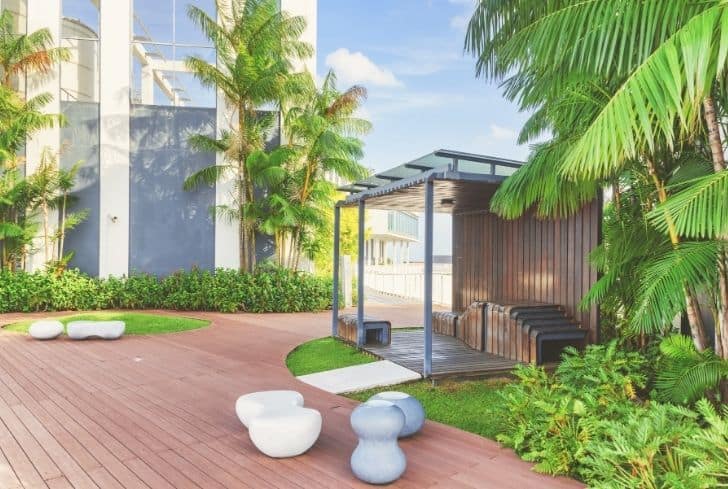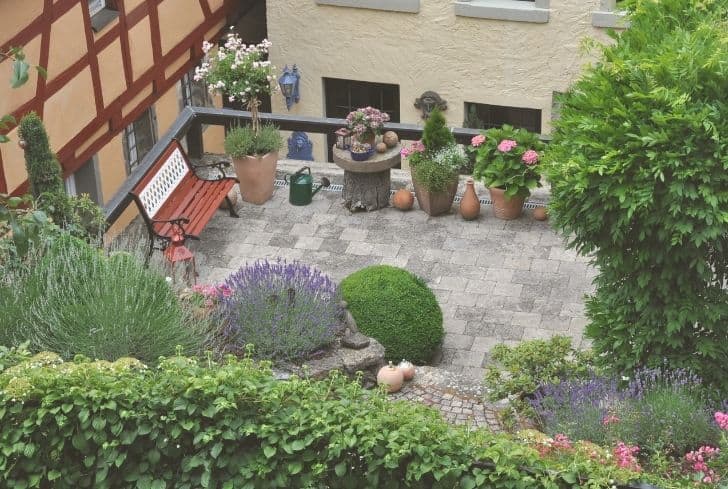Rooftop gardens defy the idea of having crops grown in a farm or a garden by adopting the concept of growing them on the topmost levels of residential, industrial, or commercial structures. In other words, rooftop gardens are artificial green spaces on top of these structures and is a growing trend in urban areas in regard to attaining environmental sustainability.
The main aim and goal behind the rooftop gardens are to lower urban temperatures, improve air quality, and better stormwater management. They can also be put in place to provide shelter or give shade, create play space, grow to produce, or create a green area. Here are some more details of rooftop gardens, especially about the history of rooftop gardens, how rooftops gardens conserve energy, and their overall benefits as green spaces installed upon the rooftops of buildings.
History of Rooftop Gardens
1. Date Back to the Mesopotamian era
Like most things from thousands of years ago, rooftop gardens also date back to the ancient ziggurats of Mesopotamia built between 4000 and 600 BC. The roof gardens formed a series of stairs along the perimeter of the stepped pyramid, providing access to various tiers of the structure. There were no interior rooms, having the trees and flowers on the terrace on the ziggurats provided a cool and shady place for visitors to the blazing sun of Babylon.
2. The Hanging Gardens of Babylon
The Hanging Gardens of Babylon are some of the most famous ancient plantings and their trailing plants reached a planted floor that was about 75 feet above the ground. They were built by King Nebuchadnezzar for his wife, Amytis, who longed for her mountainous homeland of Media. They were an engineering marvel and are perhaps the most famous roof gardens to date.
The garden’s weight was supported by arcades whose walls were 16 feet thick, and it was watered through a complex irrigation system fed by machines that were hidden from the view of the public. They obtained water that was pumped from the river Euphrates, eight feet below, to the top of the roof garden.
3. The Villa of Mysteries, Pompeii
A roof garden was found in the Villa of Mysteries in Pompeii, after the town was covered in feet of ash and pumice from the volcanic eruption of Mt. Vesuvius in AD 79. The villa was shaped in such a way that the plants were grown directly on the soil on the roof. The roof garden functioned as an outdoor living room and was the center of social activities, and was supported by an arched stone colonnade.
4. Palazzo Piccolomini, Pienza, Italy
It was the private summer residence of Pope Pius II, and was part of a wider development plan envisaged by the Pope for his hometown, Pienza. This is the earliest example of town planning in Europe and the project was celebrated for being successful in creating an ideal town. It was designed in 1463 and the roof garden was filled with sculpted trees and manicured parterres.
5. Norwegian sod roofs
In the 1890s, the Norwegians filled their sod roofs with soil and planted grasses and other plants to help stabilize the earth on the roof. Additionally, they helped mitigate damages on the roofs from rains and helped prevent them from rotting. Moreover, they strengthened the roof’s structure. The Norwegians who later migrated to Canada and the United States brought with them the same structures and designs.
6. Casino Theatre, New York City
Rooftop gardens started to emerge in New York in the 1980s and the designers envisioned them overshadowing all other forms of summer entertainment, and would be a necessary part of life. At this time, theatres in New York only run during winter months, but the introduction of the rooftop garden helped them extend their productions throughout the summer months.
It became New York’s most successful theatre and was instrumental in driving other theatres to install gardens on their roofs. In fact, Madison Square Gardens and Winter Gardens, both derive their names from their roof gardens.
7. 20th century
Architects incorporated more rooftop gardens in their designs from the early 20th century and such trends have continued to date. The Cinq Points de l’Architecture, for instance, built by Le Corbusier, was designed so that the roof garden was a flat roof which was intended to be an outdoor living room, where people would exercise and enjoy the fresh air. The roof would then offer a perfect platform on which to build a vegetated roof.
8. Today
Countries like Switzerland, Canada and France have all passed laws that demand that all commercial and residential buildings be fitted with green rooftops. Australia is also catching up, seeing that more buildings are incorporating the same, although not mandated by the law.
How Rooftop Gardens Conserve Energy?
1. “The Urban Heat Island Effect”
This phrase refers to what happens when an urban building rapidly absorbs heat from the sun. Plants on the building’s rooftop garden absorb and greatly reduce the impact of the sun. Cities with adequate greenery can soak up the sun’s rays and reduce the warmth within the city by up to 10°F.
The National Research Council of Canada, for instance, noted that during spring and summer, temperatures on a conventional roof were of the order of 45ºC and there were fluctuations in the order of 6ºC under green roofs. As such, a rooftop garden conserve energy by removing the heat from the air, providing shade to a building and reducing the overall temperatures in the surrounding rooftop space
2. They are Energy Efficient
Rooftop gardens provide great insulation to a building, retain the heat during cold seasons and maintain cool temperatures when it is very hot. As a result, air conditioning systems are replaced because their work is done more naturally by the roof gardens.
Studies in Germany have shown that 2 liters of fuel oil can be saved per square meter of a living rood per year. Additionally, there is a 3-10% winter saving on fuel bills in domestic buildings with rooftop gardens. For this reason, they conserve energy and money.
3. Helping With the Shrinking and Expansion of Buildings and Rooftops
When exposed to the sun, snow, wind and rain, most roofs change, by shrinking in cooler weather and expanding in hot weather. The shrinking and swelling shorten the lifespan of a building and its roof. Green roofs conserver the available energy and at the same time add lifespan to a building.
For instance, when the city of Roanoke, Virginia installed a rooftop garden on its municipal building, the building’s lifespan was improved by 20 to 60 years. When the lifespan and rooftops of buildings are enhanced, it eliminates the need for replacements and maintenance that may require virgin materials, which usually require energy during production.
4. They Eliminate the Need for Air Conditioning Machines
Air conditioning machines are responsible for cooling off a building when it is extremely warm or hot. In fact, about 70% of energy is spent on these systems in climates with extreme and hot temperatures.
By the fact that rooftop gardens cool off a building, implementing them would mean that these buildings will save up on their electricity expenditure in terms of air conditioning. In Chicago, for instance, with the whole scale greening on the city’s rooftops, about $100 million worth of energy could be saved each year because of reduced demand for air conditioning.
Benefits of Rooftop Gardens
1. Managing stormwater
A roof garden can greatly manage an urban city’s stormwater problems. Rooftop planters collect and filter rainwater, thereby having a more natural process of managing such water. Without these plants, the water collects on top of the buildings and concrete sidewalks and is not absorbed into the ground. Therefore, the roof garden prevents an overflow of polluted water from entering drainage systems as it collects in a more natural process.
2. You can grow your vegetables and fruits
With a garden on your roof, you will be able to grow vegetables and some fruits, at the same time saving you some vegetable shopping money. You will be able to grow your own crops, as organically as it can be, and also learn a thing or two about farming. Directly growing your own crops will also eliminate the dangers of germs and pesticides that could have been involved.
3. They cool down an area
As already mentioned in the Urban Heat Island Effect aspect above, rooftop gardens absorb the effects of the sun, controlling the temperature of a building or even a city.
4. They control noise pollution
Interestingly, rooftop gardens can help moderate noise. The soil and plants are good at absorbing, reflecting and deflecting sound waves, providing a building with considerable noise reduction, particularly for low-frequency sounds.
5. They help clean the roof
In a traditional setting, many people throw away their unused stuff on the roof. However, with a rooftop garden, you will not be tempted to do that and instead, you will dispose of them as they should be, and use the roof for a garden. The plants will also help distribute and absorb dust from the air, ensuring the roof stays clean.
6. Cleaning the air, therefore, enhancing air quality
Rooftop gardens help in reducing and filtering the air from pollutants like air particles and gases. As such, the roofs help with reducing the distribution of dust in the air and the production of smog, thereby decreasing greenhouse gas emissions in urban centers. However, you should note that one green roof cannot provide such benefits to a large area on its own; more rooftop gardens are needed to notice the positive impacts.
7. They help insects and birds to thrive, thereby boosting urban biodiversity
Rooftop gardens with their different plants can operate as a perfect habitat for many birds and insects. They act as stopovers for migrating species and allow more of these types to come into contact. Furthermore, they can help with pollination, thereby improving the overall biodiversity and healthy ecosystem of the area.
8. They can help families and friends bond
Rooftop gardens require maintenance, meaning if they are on a building where a family lives, they will all take the time to maintain it. For this reason, they help by allowing the family and friends to bond over a natural and entertaining task. They can also be used to teach the young ones how to farm, as well as with their studies in school.
9. They are beautiful
Rooftop gardens offer an admirable view for the owners as well as for the neighborhood. They make a property look more aesthetically pleasing to watch and even reside in. Furthermore, they can be a place of tranquillity, with the owners sitting there looking for some peace. They also offer privacy to the homeowner, allowing them to do what they want on their roof, like reading a book in peace out in nature.
10. They reduce carbon dioxide emissions
Most cities have their air polluted and contain too much carbon dioxide emitted from buildings, nearby factories or industries and even motor vehicles. Rooftop gardens can help such urban centers by absorbing the carbon dioxide from the air and release more oxygen in return, creating a healthier and greener urban environment.
A study in Michigan, for example, estimated that with a green rooftop in every building in Detroit, they would be able to remove the same amount of carbon dioxide as that produced by 10,000 trucks over two years.
References:
https://www.thespruce.com/rooftop-gardening-1403340
http://www.heathershimmin.com/a-brief-history-of-roof-gardens







